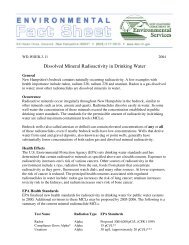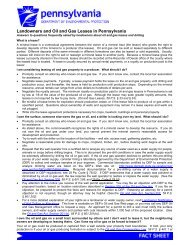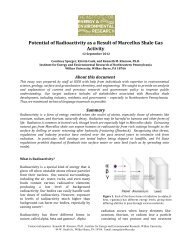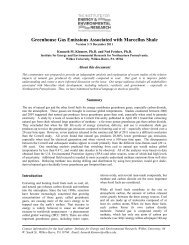Water's Journey Through the Shale Gas Drilling and Production ...
Water's Journey Through the Shale Gas Drilling and Production ...
Water's Journey Through the Shale Gas Drilling and Production ...
Create successful ePaper yourself
Turn your PDF publications into a flip-book with our unique Google optimized e-Paper software.
A. Water Acquisition<br />
About two-thirds of <strong>the</strong> fresh water used<br />
for fracing is withdrawn from permitted<br />
surface water sources <strong>and</strong> 30 percent is<br />
purchased from public water suppliers.<br />
The average amount of water used to hydraulically<br />
fracture a well is approximately<br />
4.2 million gallons, 90 percent of which is<br />
fresh water <strong>and</strong> 10 percent is reused flowback<br />
water from a previous well fracing.<br />
These numbers are based strictly on water<br />
withdrawal activity in <strong>the</strong> Susquehanna<br />
River basin in Pennsylvania from June<br />
2008 to August 1, 2011 (831 wells reporting).<br />
Surface water is a primary source for<br />
hydraulic fracturing because it is accessible<br />
to most drilling sites <strong>and</strong> is <strong>the</strong>refore<br />
less costly to use. In some cases, discharges<br />
of pollutants, such as acidic mine drainage,<br />
from upstream sources can adversely<br />
affect <strong>the</strong> quality of <strong>the</strong> water that <strong>the</strong> gas<br />
industry wishes to use, necessitating treatment<br />
before use.<br />
Regulatory requirements governing<br />
withdrawals for Marcellus drilling<br />
operations are in flux throughout <strong>the</strong> Mid-<br />
Atlantic region. Pennsylvania’s regulatory<br />
climate is currently more settled than <strong>the</strong><br />
o<strong>the</strong>rs in <strong>the</strong> region, although some observers<br />
expect fur<strong>the</strong>r revision of <strong>the</strong> state’s<br />
oil <strong>and</strong> gas laws or regulations in <strong>the</strong> near<br />
future. Because of concerns with shale gas<br />
in various parts of <strong>the</strong> country, EPA is considering<br />
more oversight of state h<strong>and</strong>ling of<br />
environmental aspects of this industry.<br />
The government institutions involved<br />
in water acquisition for Marcellus drilling<br />
<strong>and</strong> <strong>the</strong> process <strong>and</strong> approvals required<br />
differ by state <strong>and</strong> even within states<br />
(Table 1). For example, water withdrawals<br />
of any amount in <strong>the</strong> Susquehanna River<br />
watershed to develop gas wells in <strong>the</strong><br />
Marcellus <strong>and</strong> o<strong>the</strong>r shale formations require<br />
approvals from <strong>the</strong> SRBC, a federal/<br />
interstate commission that seeks to protect<br />
<strong>and</strong> manage <strong>the</strong> water resources of <strong>the</strong> basin.<br />
Water withdrawals are also regulated<br />
by <strong>the</strong> PaDEP throughout Pennsylvania,<br />
including in areas of <strong>the</strong> state within <strong>the</strong><br />
Ohio River basin. The Delaware River<br />
Basin Commission has <strong>the</strong> authority to<br />
regulate water withdrawals <strong>and</strong> discharges<br />
<strong>and</strong> is currently developing regulations<br />
specifically for <strong>the</strong> natural gas industry.<br />
Regardless of which river basin <strong>the</strong> water<br />
source is located in, an approved water<br />
management plan is required as a special<br />
condition of a well permit under <strong>the</strong> Oil<br />
<strong>and</strong> <strong>Gas</strong> Act throughout Pennsylvania.<br />
Chuck Anderson<br />
Table 1. Water withdrawal requirements <strong>and</strong> state of <strong>the</strong> industry in <strong>the</strong> Mid-Atlantic states.<br />
Jurisdiction Activity Water withdrawal requirement<br />
Pennsylvania Active drilling <strong>and</strong> production Water management plan required for Marcellus<br />
operations throughout state; Act 220 (Water<br />
Resources Planning Act) requirements must also<br />
be met if withdrawal meets Act 220 threshold<br />
Susquehanna Active drilling <strong>and</strong> production Above, plus SRBC approval required<br />
River basin<br />
Delaware<br />
River basin<br />
<strong>Drilling</strong> suspended pending<br />
development of revised<br />
regulations by Delaware River<br />
Basin Commission (DRBC)<br />
Water management plan, Act 220 requirements,<br />
plus DRBC approval required<br />
New York<br />
State government is taking<br />
steps to end effective<br />
moratorium on Marcellus<br />
drilling<br />
New water withdrawal permitting law passed;<br />
applications for withdrawal of 2 million gallons a<br />
day or more will likely be due by Feb. 2015, while<br />
those for 0.5–1.99 MGD will not be due until Feb.<br />
2016;* SRBC approval would also be required<br />
West Virginia Active drilling <strong>and</strong> production Water management plan to West Virginia<br />
Department of Environmental Protection required<br />
for companies that withdraw more than 210,000<br />
gallons of water per month<br />
Maryl<strong>and</strong><br />
Leasing activity; a few<br />
drilling permit applications;<br />
Department of <strong>the</strong> Environment<br />
proposed two-year drilling<br />
delay (Feb. 2011)<br />
*See “Draft Supplemental Generic Environmental Impact Statement,” www.dec.ny.gov/energy/75370.html. The new law<br />
was signed on August 15, 2011.








